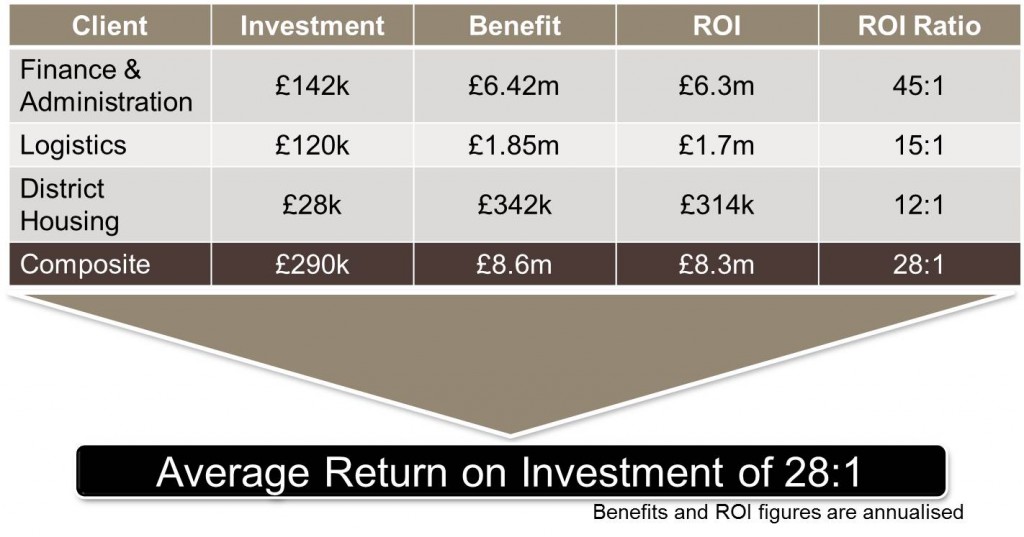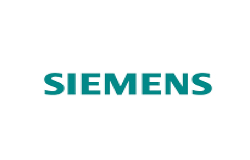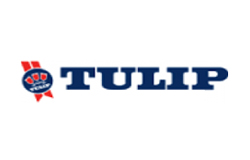LOGISTICS
Problem Statement
The Distribution Centre (DC) is currently experiencing high levels of delivery failures giving a service level performance of only 94.2%. As a result, customers (the branches) are losing sales – estimated at £118k per month (£1.4m per year) – and losing customers to their competitors. The estimated annualised projected cost to the business is as follows:
| Re-delivery costs/year | £240k |
| Lost sales/year | £1.4m |
| Agency costs/year | £335k |
| Rework process time/year | £62k |
| Estimated annual projected costs | £2.037m |
The objective of the project:
“Deliver a [sustainable] solution to the existing problem with a key target of achieving a service level of > 98.5%”
The company enlisted Dembridge to assist them in identifying the root cause of the problem and to deliver a sustainable solution.
The Approach
To enable a dynamic approach to the problem, a full week’s intensive training programme was undertaken with selected representatives from each of the DC functions. These representatives were trained to ‘Green Belt’ standard. These newly skilled people formed the project team and worked under the direction of the Dembridge Black Belt.
A series of small workshops was undertaken with those involved to fully understand the process steps within the value stream, identifying those that did not add any value and removing those same processes.
This complete end-to-end process mapping exercise identified a considerable number of non-value adding processes including barriers to the flow of materials and communications.
The Findings
Resultant from the measurement and analytical phases of the project it was established that a series of unnecessary processes throughout the value stream were in existence. The delays in the receiving process through ineffective processes generated high levels of downtime for the subsequent processes resulting in unproductive work (people do nothing whilst waiting for the preceding process to be completed) which caused a ripple effect to downstream processes.
Throughout the entire DC process – from the point of an inbound delivery arriving on site to the delivery of the order – a total of 2,456 different processes were recorded.
The Solution
Working with the team, agreement was reached to eliminate a significant level of the non-value adding processes which would facilitate a smooth flow across the functions, moving to ‘pull’ rather ‘push.’ The key changes made were:
- Redefining the process for booking deliveries (working with the suppliers)
- Eliminating non-value adding processes
- Cross-functional training and awareness
Through the rigorous exercise a total of 1,311 processes (53%) were eliminated – the equivalent of 69 hours per day. As part of the project, a suite of Standard Operating Procedures was drawn up and trained in to all DC personnel including all revised process maps.
The Benefits
In accordance with the project definition and subsequent objective, and utilising the Lean Six Sigma methodology – Define, Measure, Analyse, Improve, Control (DMAIC) – all targets were met with significant tangible benefits including:
| Cost Concern | Estimated Cost | Revised | Saving/Gain |
| Re-delivery costs/year | £240k | £9k | £231k |
| Lost sales/year | £1.4m | £120k | £1.18m |
| Agency costs/year | £335k | £48k | £287k |
| Rework process time/year | £62k | £8k | £54k |
| Estimated annual projected costs | £2.037m | £185k | £1.852m |
In addition to the reduction in lost sales – on a like-for-like basis – sales actually increased by 19% over the ensuing 3 months following implementation of the changes. The enablers to the achievement of these impressive results were:
- Voice of the Customer exercise to attain specific requirements
- A rigorous people engagement programme
- A clear project plan built around the DMAIC methodology
- Effective communications across the population
- Comprehensive Value Stream Mapping/Process Mapping
- Implementation of a ‘Rapid Action Team’ to facilitate the achievement of quick wins
- An overall reduction in processes of 53%
- Sustained service levels of 99.1%
Conclusion
Considerable benefits were realised through the deployment of Lean and Six Sigma methodologies as a result of the simplification of processes and real engagement of people within the process itself. Under strong leadership, with a firm commitment to the programme, the results achieved were well within the defined timescale.
The significance of the benefits realised has enabled not only the achievement of the project objective but also a sustainable process that promises to continue to provide value to the business but also to the most important of all – the customer!
FINANCE AND ADMINISTRATION
Problem Statement
Stock availability was being severely impacted due to the late payment of invoices. Due to this many suppliers had put the business ‘On stop’ and refused to supply products until the payments were made. The further impact of this was the decline in sales.
It was estimated that over 23% of invoices were paid late to suppliers which equated to around 2,700 per month over the last 3 months. It was further estimated that a correlation existed between the drop in sales of some key lines and those invoices that were not paid within the terms of the agreement. The estimated sales loss was £670,000 per month
| No. of invoices not paid on time/year | 32,400 |
| Percentage of invoices not paid | 23% |
| Estimated loss of sales/year | £8m |
The objective of the project:
“Reduce the level of payments made late to less than 10% of received invoices. This target is to be met within 2 months of the project start.”
The company enlisted Dembridge to assist them in identifying the root cause of the problem and to deliver a sustainable solution.
The Approach
To enable a dynamic approach to the problem, a full week’s intensive training programme was undertaken with selected representatives from each of the functions. These representatives were trained to ‘Green Belt’ standard. These newly skilled people formed the project team and worked under the direction of the Dembridge Black Belt.
Starting at the customer (supplier) end, a value stream mapping exercise was undertaken in order to understand the flow of work across each function. This mapping exercise included representation from all those involved in the value stream. From this exercise we determined a number of key statistics including; process times, supplier information, communications, information flow and lead times. We then deduced where any bottlenecks occurred and where improvement opportunities could be gained.A series of small workshops was undertaken with those involved to fully understand the process steps within the value stream, identifying those that did not add any value and removing those same processes. This complete end-to-end process mapping exercise identified a considerable number of non-value adding processes including barriers to the flow of materials and communications.
The Findings
Resultant from the measurement and analytical phases of the project it was established that a series of unnecessary processes throughout the value stream were in existence. As we went through the processes it became clear that the root cause of the problem resided in the communications and authorisation levels.
There were a number of key factors that impacted on the process including; inaccurate supplier information; authorisation limits; communications and the flow of received invoices (both electronic and paper) into the purchase ledger department. In all, a total of 797 processes were in existence from the point of invoice creation to actual payment into the supplier’s bank account.
The Solution
Working with the team, agreement was reached to eliminate a significant level of the non-value adding processes which would facilitate a smooth flow across the functions, moving to ‘pull’ rather ‘push.’ The key changes made were:
- Redefining the process for the receipt and management of invoices
- Improving the process to enable the accurate submission of invoices (by the supplier)
- Reducing the processes involved in actioning the invoices
- Eliminating non-value adding processes
- Cross-functional training and awareness
- Supplier/customer integrated processes
- Changes to the communications processes
- Review and changes to the authorisation levels within the finance department
Through the rigorous exercise a total of 383 processes (48%) were eliminated – the equivalent of 39 hours per day. As part of the project, a suite of Standard Operating Procedures was drawn up and trained in to all purchase ledger personnel including all revised process maps.
Engagement with the suppliers played a major part in achieving this goal who were involved in the process improvement programme. This was seen as key in ensuring the end-to-end processes flowed smoothly which would benefit all parties concerned
The Benefits
In accordance with the project definition and subsequent objective, and utilising the Lean Six Sigma methodology – Define, Measure, Analyse, Improve, Control (DMAIC) – all targets were met with huge tangible benefits including:
| Issue | As-is Metric | Revised | Improvement |
| No. of invoices not paid on time/year | 32,400 | 5,723 | 26,677 |
| Percentage of invoices not paid | 23% | 5.3% | 76.9% |
| Estimated loss of sales/year | £8m | £1.7m | £6.3m |
The company took advantage of these improvements to decrease their costs further leading to an additional annualised company saving of £140K. The enablers to the achievement of these impressive results were:
- Voice of the Customer exercise to attain specific requirements
- A rigorous people engagement programme
- A clear project plan built around the DMAIC methodology
- Effective communications across the population
- Comprehensive Value Stream Mapping/Process Mapping
- Implementation of a ‘Rapid Action Team’ to facilitate the achievement of quick wins
- An overall reduction in processes of 42%
- Changes to authorisation levels
- Changes to tolerance levels for payment of invoices
- Improvements in accuracy of invoice details by the supplier
Conclusion
Considerable benefits were realised through the deployment of Lean and Six Sigma methodologies as a result of the simplification of processes and real engagement of people within the process itself. Under strong leadership, with a firm commitment to the programme, the results achieved were well within the defined timescale.
The significance of the benefits realised has enabled not only the achievement of the project objective but also a sustainable process that promises to continue to provide value to the business but also to the most important of all – the customer (supplier)!
CUSTOMER SERVICE
Problem Statement
The District Housing group was suffering from high levels of down time due to the lengthy process of collecting orders from the service provider. This collection process was impacting on maintenance schedule creating delays to the committed repairs to its customers.
The lead time for repairs had risen from typically 48 hours to almost 5 days in many cases, during the last 4 months. The level of complaints had risen by over 40% and had, reportedly been registered as the highest level of complaints in the industry. Additionally, stock availability became an issue with the level of out of stock items running at an average 11% of total inventory.
| Engineer down-time/day | 17 hours |
| No. of repairs completed/day | 38 |
| Down-time cost/year | £58k |
| Complaints/day | 16 |
| Out of stock levels | 11% |
| Average customer on-site time/visit | 18 minutes |
The objective of the project:
“Reduce the level of engineer downtime by at least 60% whilst improving stock availability to a level greater than 97.5%”
The company enlisted Dembridge to assist them in identifying the root cause of the problem and to deliver a sustainable solution.
The Approach
To enable a dynamic approach to the problem, a full week’s intensive training programme was undertaken with selected representatives from each of the functions. These representatives were trained to ‘Green Belt’ standard. These newly skilled people formed the project team and worked under the direction of the Dembridge Black Belt.
Starting at the customer end, a value stream mapping exercise was undertaken in order to understand the flow of work across each function. This mapping exercise included representation from all those involved in the value stream. From this exercise we determined a number of key statistics including; cycle time, customer service time, inventory management processes and lead times. We then deduced where any bottlenecks occurred and where improvement opportunities could be gained.
A series of small workshops was undertaken with those involved to fully understand the process steps within the value stream, identifying those that did not add any value and removing those same processes.
This complete end-to-end proves mapping exercise identified a considerable number of non-value adding processes including barriers to the flow of materials and communications.
The Findings
Resultant from the measurement and analytical phases of the project it was established that a series of unnecessary processes throughout the value stream were in existence. As we went through the processes it became clear that the root cause of the problem resided in the stock management system, in particular the stores layout.
The lack of discipline within the warehouse function with poor location labelling and inappropriate location of prime stock led to considerable levels of non-value processes to the compromise of efficient and effective customer service.
In all, a total of 1,074 processes were in existence from the point of order to the point of providing the customer with the requisite product. This significantly added to the time spent to serving the customer and resulted in the delays in undertaking repairs.
The Solution
Working with the team, agreement was reached to eliminate a significant level of the non-value adding processes which would facilitate a smooth flow across the functions, moving to ‘pull’ rather ‘push.’ The key changes made were:
- Redefining the process for supplier ordering
- Relocation of high throughput items closer to the point of service
- Reducing the processes involved in engineer ordering
- Eliminating non-value adding processes
- Cross-functional training and awareness
Through the rigorous exercise a total of 412 processes (38%) were eliminated – the equivalent of 12.5 hours per day. As part of the project, a suite of Standard Operating Procedures was drawn up and trained in to all relevant company personnel including all revised process maps.
The Benefits
In accordance with the project definition and subsequent objective, and utilising the Lean Six Sigma methodology – Define, Measure, Analyse, Improve, Control (DMAIC) – all targets were met with huge tangible benefits including:
| Issue | As-is Metric | Revised | Saving/Gain |
| Engineer down-time/day | 17 hours | 2.4 hours | 14.6 hours |
| No. of repairs completed/day | 38 | 64 | 26 |
| Down-time cost/year | £58.4k | £8.2k | £50.2k |
| Complaints/day | 16 | 2 | 14 |
| Out of stock levels | 11% | 2.1% | 8.9% |
| Average customer on-site time/visit | 18 minutes | 6.5 minutes | 11.5 minutes |
The company took advantage of these improvements to decrease their costs further leading to an overall annualised company saving of £370K. The enablers to the achievement of these impressive results were:
- Voice of the Customer exercise to attain specific requirements
- A rigorous people engagement programme
- A clear project plan built around the DMAIC methodology
- Effective communications across the population
- Comprehensive Value Stream Mapping/Process Mapping
- Implementation of a ‘Rapid Action Team’ to facilitate the achievement of quick wins
- An overall reduction in processes of 38%
Conclusion
Considerable benefits were realised through the deployment of Lean and Six Sigma methodologies as a result of the simplification of processes and real engagement of people within the process itself. Under strong leadership, with a firm commitment to the programme, the results achieved were well within the defined timescale.
The significance of the benefits realised has enabled not only the achievement of the project objective but also a sustainable process that promises to continue to provide value to the business but also to the most important of all – the customer!
Sign up to our mailing list and receive regular new articles on how Dembridge has assisted its clients in achieving outstanding returns on investment and also receive TOP TIPS on how you can improve your performance. Just complete the mailing list on the right – IT’S FREE!















